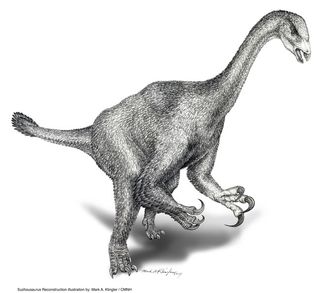Big Waddling Dinosaur Discovered

A strange, long-necked waddling dinosaur with massive arms and probably enormous claws has been discovered. It walked only on its hind legs like the carnivorous dinosaurs from which it evolved, but Suzhousaurus megatherioides, meaning "giant sloth-like reptile from Suzhou," was an herbivore, says researcher Daqing Li of the Third Geology and Mineral Resources Exploration Academy of Gansu Province in northwestern China, where the fossil specimen was found. The creature belongs to a group of dinosaurs called therizinosaurs, characterized by long necks capped by small heads, massive arms and claws, and flaring ribs and hips that made their bodies very wide. "Suzhousaurus is unique in being the oldest well-known, very large member of this group of dinosaurs," Li said. The dinosaur was formally named, on the basis of one specimen, in a study published recently in the journal Acta Geologica Sinica. Li and his colleague Hailu You of the Chinese Academy of Geological Sciences found the animal's partial skeleton, which includes most of the back vertebrae, the shoulder, the front leg and part of the hips. New era Previously, big therizinosaurs like this were known only from about 90 million to 66 million years ago, near the end of the Age of Dinosaurs, but Suzhousaurus was around about 115 million years ago, during the early Cretaceous Period. When first found, therizinosaurs were thought to be gigantic turtle relatives and later some kind of weird theropod. Then they were thought to be related to sauropods, and some people thought they were a lineage separate from sauropods and theropods that originated all the way back to the in late Late Triassic when dinosaurs first evolved, said study team member Matt Lamanna of Carnegie Museum of Natural History. Then, in the '90s, paleontologists agreed that therizinosaurs are very modified theropods that had gone vegetarian. They have smaller leaf-shaped teeth like many other plant-eating dinosaurs rather than the sharp, serrated teeth of most other theropods. Therizinosaurs are thought to be closely related to birds. Based on the discovery of feather-like structures in one ungainly member of the group, Beipiaosaurus, therizinosaurs were probably all feathered, Lamanna said. Despite being herbivores, therizinosaurs retained the three-clawed forelimbs typical of many other theropods, which they might have used to pull tree branches toward their mouths like giant ground sloths and for defense against carnivorous dinosaurs. Big beast Suzhousaurus was big compared to most of its feathered theropod relatives, measuring about 7 yards (6.5 meters) from head to tail. It is one of the largest known therizinosaurs, and probably the largest known from the Early Cretaceous. Its upper arm bone is among the longest-known of any theropod, Lamanna said. Suzhousaurus' closest known relative may be Nothronychus, fossils of which have only been found in somewhat younger rocks in New Mexico and Utah. This suggests that dinosaurs regularly traversed a transitory land bridge between North America and Asia early in the Cretaceous Period, said Lamanna and Jerry Harris of Dixie State College of Utah, who determined the evolutionary relationships of Suzhousaurus. "More and more, paleontologists are discovering similar kinds of dinosaurs in rocks of Early Cretaceous age in both eastern Asia and western North America," Lamanna said. "The most primitive known therizinosaur comes from Utah, so the group may have originated in North America, but they apparently evolved larger body size relatively quickly once they got to Asia." The dinosaur lived on a warm, semi-arid plain dotted with shallow, temporary lakes, said study co-author Ken Lacovara of Drexel University, who studies the environment that Suzhousaurus lived in. "It shared its world with a host of other Early Cretaceous dinosaurs, including giant, long-necked, plant-eating sauropods and early relatives of duck-billed herbivores," he said.
- Gallery: Dinosaur Fossils
- Gallery: The World's Biggest Beasts
- Top 10 Most Incredible Animal Journeys
Sign up for the Live Science daily newsletter now
Get the world’s most fascinating discoveries delivered straight to your inbox.
Robin Lloyd was a senior editor at Space.com and Live Science from 2007 to 2009. She holds a B.A. degree in sociology from Smith College and a Ph.D. and M.A. degree in sociology from the University of California at Santa Barbara. She is currently a freelance science writer based in New York City and a contributing editor at Scientific American, as well as an adjunct professor at New York University's Science, Health and Environmental Reporting Program.
Most Popular



